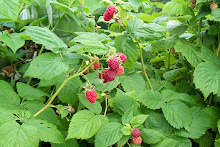 Here they are, plotting against me, I'm sure the two with their heads down are in cahoots!
Here they are, plotting against me, I'm sure the two with their heads down are in cahoots!I got a few different types of birds this year and may-be that is what is adding to the challenges but I don't see why. I mean a chicken is a chicken, right? Apparently not. I tried to get breeds that are very mellow and calm but I guess personality trumps genetics every now and then.
I really like having green eggs so I got six Americauna eggs plus two day old chicks and three or four Americauna mixes from my own Leah. And out of the twelve, I might have two females! Arrrggg!
 I'm pretty sure this little Americauna cross is a female. (please, please, please!!!)
I'm pretty sure this little Americauna cross is a female. (please, please, please!!!)I decided to get other laying hens, too so I ordered six from the feed store. Good thing I did, considering the male Americana fiasco. I think these hens are hybrids. They will lay brown eggs. They're very mellow and not shy at all. While they are smaller than the dual purpose chickens, they get along famously with everybody. And the best thing about them, I know they're hens because that's what I ordered.
`

`
`
`
`
`
`
`
The laying hens colouring differs by shade of brown and the amount of white. It is kind of nice, adds a little pizazz to the coop. `
`
Another breed new this year is Delaware. They're a duel purpose bird, said to be very mellow and sweet. Ha!!! Not when compared to my wonderful Partridge Chanticlers and Buff Orpingtons. A couple of the roos have real attitude. They are a pretty bird, though; white with black speckles on the tail and around the neck.
`
 Here's one doing his early morning calisthenics. Don't ask me why, I don't have a clue.
Here's one doing his early morning calisthenics. Don't ask me why, I don't have a clue. Some Delawares have lots of black speckles. I think this one is a female...may-be...perhaps.
Some Delawares have lots of black speckles. I think this one is a female...may-be...perhaps. Others barely have any speckles. But they're still growing so that might change.
Others barely have any speckles. But they're still growing so that might change.The big issue right now is the cockerels being jerks. Last year they just hung together being jerks only when the opportunity arose. This year, they're constantly at each other and chasing the hens relentlessly. No-one has gotten seriously injured yet but I think it's coming and that is something I want to avoid at all costs. So I'm trying to separate these teenagers according to sex but it's difficult for me still. I think someone is a male, stick him with the other males and then it's obvious he's a she, put her back with the pullets and ~voila~ she turns back into a he. They're doing it on purpose, I'm sure of it.

So I spent the better part of a morning re-arranging the chooks again. I don't think it's perfect but it seems to be very much improved. Almost no squabbling and the pullets are much more relaxed and happy. I put the biggest, toughest teenage roos in the big coop where the adults will keep them in line. They are adjusting to life in the 'big house' well so far. So it's just a matter of watching closely and continue to be on the alert for chickens changing sex just for the amusement of seeing me go insane.
 I can't tell you what sex either of these two are but I'm pretty sure the one on the left is a cat.
I can't tell you what sex either of these two are but I'm pretty sure the one on the left is a cat.

No comments:
Post a Comment